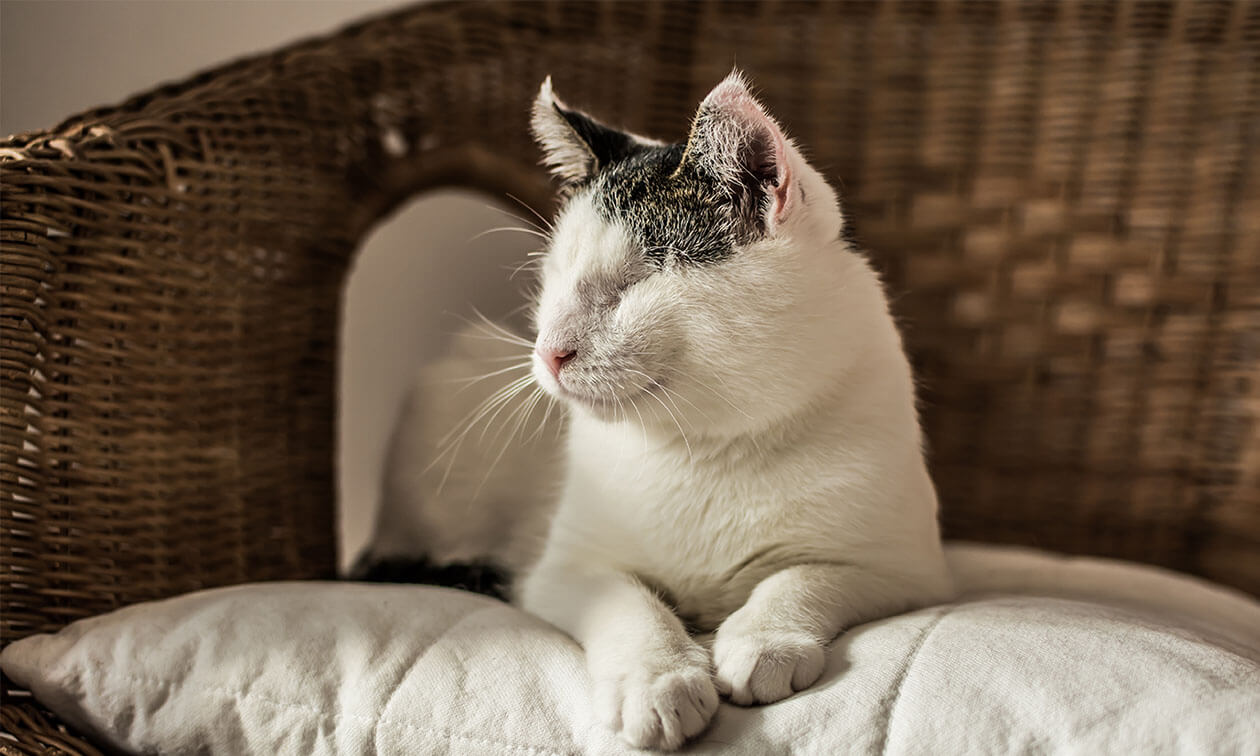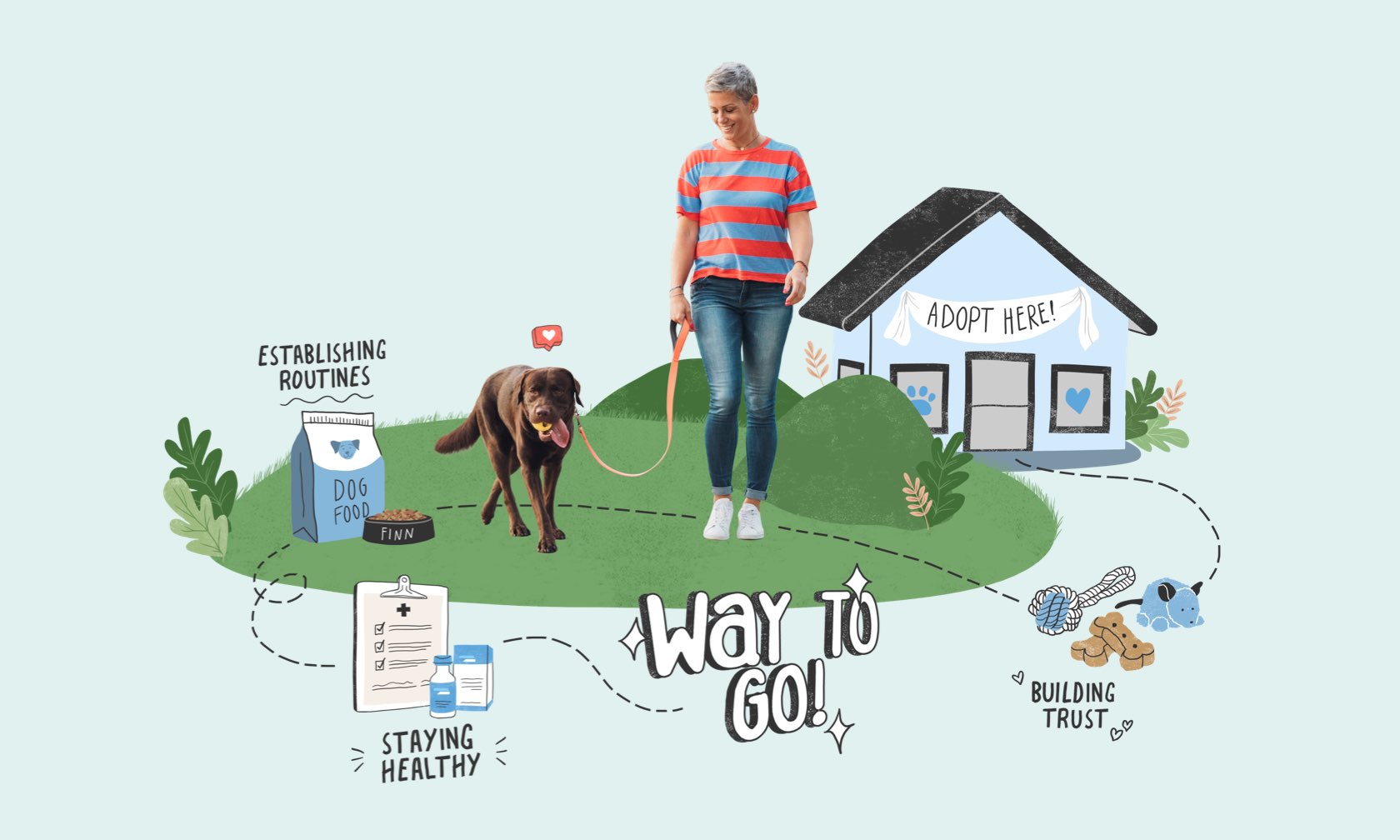Many people have blind pets, whether their cat or dog was born without sight or lost it over the course of their lives. The great thing is that most adjust to it beautifully. They use their remaining senses to compensate for the lack of vision.
Adopting a blind cat or dog requires a little extra care and responsibility, but with a loving family providing a little extra support, they can lead long, happy lives.
Introducing a Blind Pet to Your Home
As your blind pet acclimates to their new environment, they may bump into walls, furniture, and items on the floor. A bumper collar (sometimes called a halo harness) can be helpful to minimize potential injury and let them move around more freely. It’s a barrier between your blind pet and the object, bumping into it before they do. This makes them aware of the object, so they can safely walk around it.
Dogs
Start out by giving them a feel for the layout of your home and yard by walking them through each area on a leash. A head collar attached to the leash will give them even more guidance. If your dog isn’t already familiar with this type of collar, you may need to spend a little time getting them comfortable with it in a positive way before using it for exploration. Offer treats and praise, making it a fun adventure. Pause at stationary objects, like furniture and walls, allowing your dog to explore and become familiar with their location.
Designate one area of your home for their food and water bowls, dog bed, and crate so they can easily get to those key resources. Until your dog adapts, you may want to keep them in their designated area when you are not available to guide them to it.
Cats
Cats are a little different than dogs. Your cat should have a designated room with their food and water bowls, bedding, and a litter box positioned at least a few feet away from the other items.
Help your cat get comfortable in the room by spending time with them and offering affection, play, and treats. Of course, if you have an anxious kitty, be respectful and go through a slower process to get them used to your presence.
Once your cat is comfortable in this room, expand their territory to other rooms in the home. Let them come out on their own and explore as they’re ready. You can use food or toys as a lure and positive reinforcement. These excursions should be supervised until your cat has the lay of the land.
Home Modifications for Blind Pets
If you’re thinking about adopting a blind dog or cat, keep in mind that you will need to make adjustments to your home. Over time, a visually impaired animal will learn the layout of their home and move around reliably. Even so, there are some things to keep in mind to ensure that your pet stays safe, like blocking off stairs, covering corners, and keeping the same layout.
Keep a consistent layout. Once your pet is familiar with the layout of your home, avoid rearranging furniture or changing the location of their essentials, like food and water bowls, bedding, etc.
Get a pet’s-eye-view. Get down to your dog’s or cat’s level in your home and yard, identifying potential hazards and ways to help your blind pet navigate them or protect your pet from them.
Avoid clutter. Keep floors, and especially walking paths, clear of clutter.
Watch the stairs. Until your pet can navigate the stairs safely, block them off. Work with them on getting up and down. Consider adding a secure rug of a different texture at the top and bottom of the stairs as their physical cue the stairs are in front of them.
Block access to windows and balconies. This is especially important for cats who can easily jump five or more feet straight into windows and for cats and small dogs who might be able to walk between the spindles of a balcony or stair railing.
Cover sharp corners. Use corner guards or bubble wrap to cover furniture corners, especially at your pet’s eye level.
Make a path. Use carpet runners to create easy-to-follow paths so your pet can move easily through the home.
Use a bell. Consider having other pets wear a breakaway collar with a bell. This can make your blind pet feel more secure, being able to hear where everyone is.
Make your presence known. As you enter and leave rooms where your blind pet is hanging out, give a little verbal greeting, so they aren’t startled if they don’t hear you walk in.
Don’t forget to safety-proof your outdoor space too. Blind cats shouldn’t be allowed outside (beyond a catio or on a leash) but blind dogs still need daily outdoor access.
Do some trimming. Trim bushes with branches at your pet’s eye level.
Create a barrier. Use a different texture, like mulch or rocks, around trees and other areas you want your pet to avoid.
Make water safety a priority. Fence off inground swimming pools and fishponds.
Provide supervision. A blind dog or cat can become easily disoriented and need your help getting their bearings.
Introducing a Blind Dog or Cat to Other Pets
After adopting a blind cat or dog, they will need to be introduced to your other pets. Fortunately, the introduction process for blind pets isn’t all that different than that of sighted pets. Do a little research on introduction methods for the pets you’re introducing.
One important thing to remember about blind dogs and cats is that they cannot see and interpret the body language of the other pet, which is an essential form of communication. So, you’ll be their eyes when doing introductions and discontinue the introduction session if anyone’s body language indicates discomfort. Over time, they’ll learn to communicate in other ways.
Play and Enrichment with Blind Pets
Rely on your blind pet’s other senses, like hearing, scent, and taste, to encourage play — toys that squeak when touched, the sound of a paper bag when scrunched, balls laced with an inviting smell (vanilla or coconut for dogs and catnip or honeysuckle for cats), food puzzles that reward with a treat.
Blind pets respond well to clicker training. Using the click to mark the desired behavior, followed immediately by a reward, you can teach your dog or a cat to do various fun activities like high five or finding a hidden treasure. Be creative! It is a great confidence booster too.
Walks are a great way of providing exercise and socialization. For dogs, walk them on a leash. Using a front-attachment harness gives you a bit more control to help guide your dog. If they’re comfortable in the head collar, that works well too. For cats, use a leash and harness and follow safety practices like taking a carrier with you in case your cat gets startled or escapes their harness
Health Concerns with Blind Pets
Adopting a blind dog or cat doesn’t necessarily come with more medical issues or expenses. There are a variety of causes of blindness in dogs and cats. Some require more monitoring and treatment than others. Work with your family veterinarian and possibly a veterinary ophthalmologist to determine the best health plan for your blind pet.
ZPC-02548





